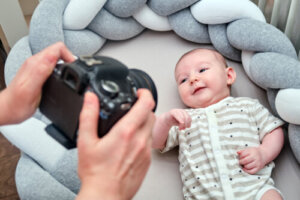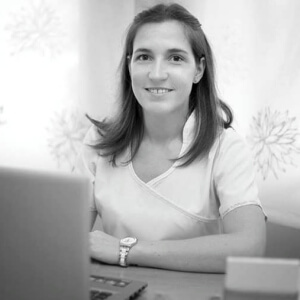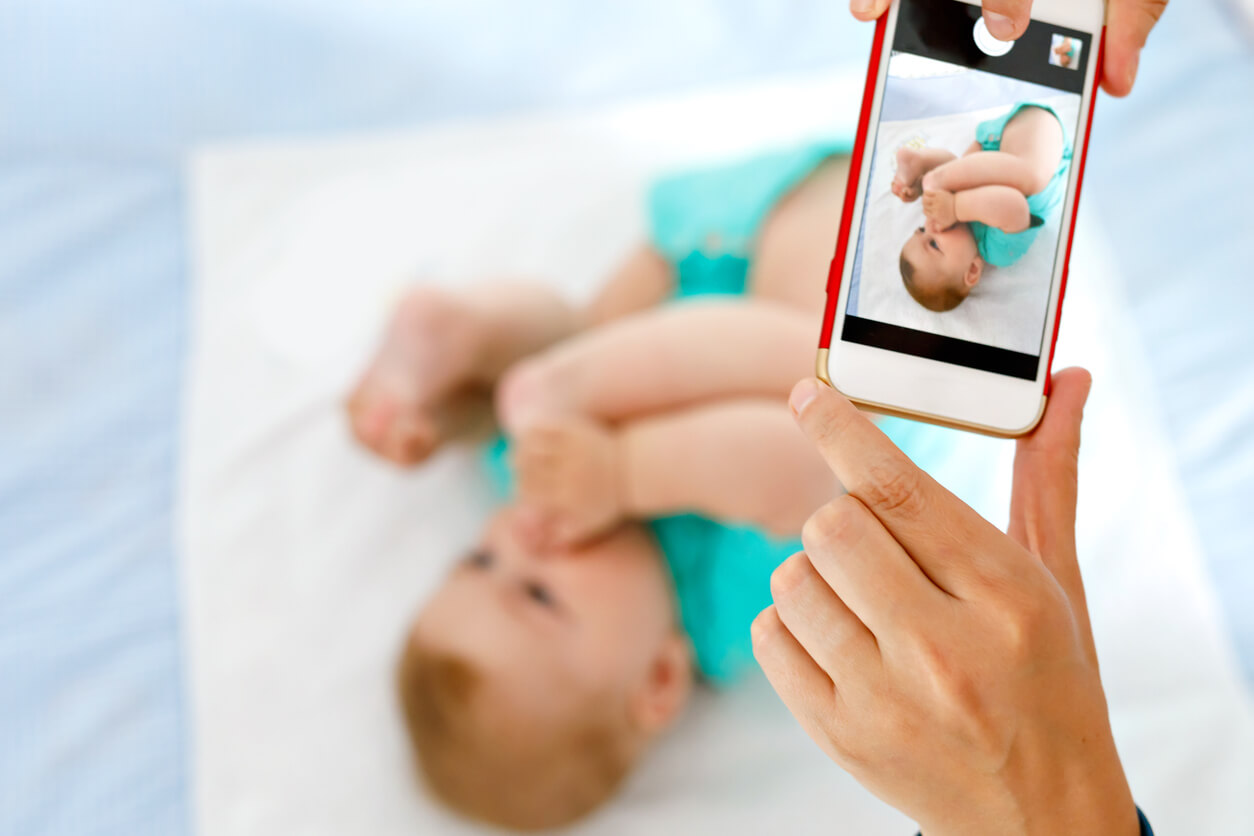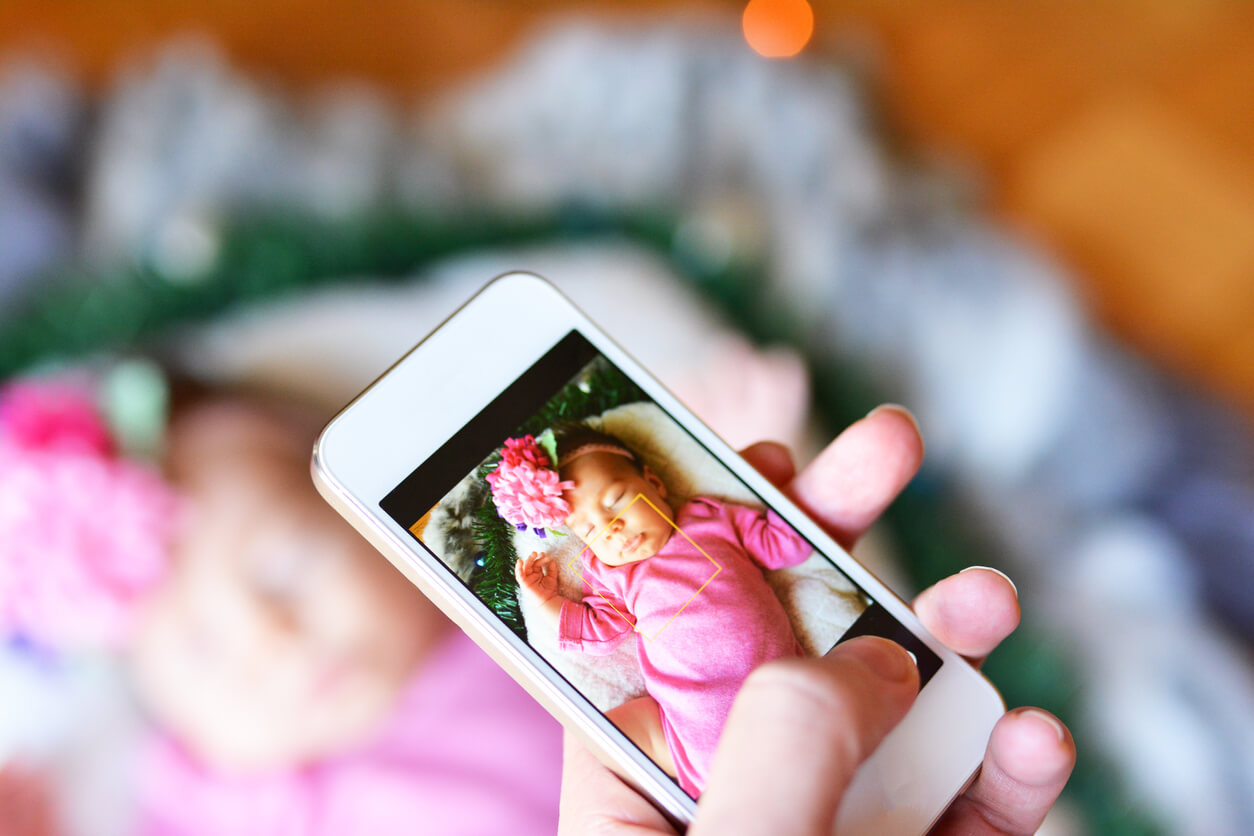11 Tricks to Take the Best Baby Pictures


Reviewed and approved by the pediatrician Marcela Alejandra Caffulli
Immortalizing your baby’s beautiful moments in photographs, such as their first smiles, first steps, or the first time they eat by themself, isn’t always an easy task. Getting them to come out beautiful, smiling, and without strange looks on their faces, requires patience and a series of tips to consider in order to capture the ideal pose. In this article, we’ll show you some tricks to take the best baby pictures.
Whether you use a professional camera or your cell phone, it’s important to know how to take the best pictures possible. To do this, you must focus, use the right light and framing, and avoid backgrounds that cause visual noise and are natural. Keep reading and you’ll know how to do it!
Learn the tricks to take the best baby pictures
Capture the most fun, playful, tender, and loving moments with your baby. This way, you’ll be able to keep their smiles, their looks, or their first steps forever. Here are some tips to keep in mind when you start the adventure of taking the best baby pictures.
1. Keep your camera handy
To capture your baby’s unforgettable moments, you should always be prepared. Have your camera or phone handy. Nowadays, the latest generation of mobile devices have very high-resolution cameras and take sharp, high-quality photos. Thus, you probably won’t have to resort to a traditional camera, as your cell phone will be enough. Just keep it handy for when it’s time to click.
2. Don’t wait to get the ideal pose
Every baby moment is important to you. So don’t wait for the ideal pose or for them to look directly at the camera. Instead, photograph them when they’re off guard so that they present their most natural pose and feel comfortable.

3. Have a helper
Have a helper nearby to distract the child while you take pictures. You can get their attention with noises by shaking a rattle or trying to make them laugh. For your part, you’ll need to keep an eye out at all times to capture the best images.
4. Capture their emotions
Capturing a baby’s big moments is what excites parents the most. Their smile, a laugh, a pout, when they frown or make an angry face, and even when they cry. It’s important to capture all these experiences in photographs to remember them forever and share them with the whole family.
5. Get close to take a portrait
Try to get close in order to get a good portrait of your baby. If your camera doesn’t have a zoom lens or you’ve already zoomed it to its maximum, take several steps toward your baby. Also, there are now phones that have a portrait function, which blurs the background and keeps the focus on what you’re interested in, in this case, your baby’s face.
6. Try to take artistic pictures
As you’re looking to take the best pictures of the baby, try to take some artistic ones. You can take a shot of their hands when he grabs their first toy or bottle, or capture the image of their little feet. You can also take a capture of the baby’s intertwined hands next to mom and dad‘s.
7. Include the family
Although the main character of your photo shoot is the baby, a beautiful and tender gesture is to include the family. If the baby has a sibling, take pictures of the older child when they’re taking care of or hugging their little brother or sister. Or even holding the baby in your arms. Likewise, pictures with parents or grandparents represent beautiful memories worth treasuring.
8. Put yourself at the child’s height
Another trick to taking the best baby pictures is to put yourself at your child’s height. If they’re sitting on the floor, it’s best to get down on the floor to take pictures of them. Don’t be afraid to try different framing and perspectives, even if you have to kneel or even lie down to get the desired image.

9. Choose the clothes your child’s going to wear
To get good pictures, you must know how to choose the clothes the child will wear for the session. It’s best to dress them in bright, cheerful, and plain colors. Avoid stripes, checks, or small prints, because they tend to get confused in the photo.
10. Choose a good background
Before you start taking pictures of your baby, take a look at the background. Make sure the background is clean and tidy, there are no piles of clothes, piles of toys, or any other objects that cause visual noise. In this context, look for a simple, plain, but beautiful background. This can be inside or outside the house, a garden, or a wall that has a nice color or fabric.
11. Take advantage of natural light
A nice photo is achieved with good lighting. In this sense, the best light for photographing babies is natural light, either at dusk or dawn, as it’s softer at those times. If you’re indoors, use a room that has plenty of natural light. To do this, draw the curtains or raise the blinds.
Another option is to take photos outdoors. If so, avoid having the sun in front of the camera so that the image isn’t backlit. Also, don’t put the child in front of the sun, because they’ll close their eyes.
Likewise, the use of flash or bright sunlight isn’t recommended because it’s uncomfortable and distracting for little ones. If there’s too much sunlight, diffuse it with a sheet or some white cloth. You can put your baby in the shade, but be sure not to cast strong shadows on their face.
Treasure your baby’s best moments
As a mother, you’ll be thrilled to capture every important moment of your child in pictures. Photos tell a story and document moments of their life and the different stages of their development. For you, it will be a very special gift to live the adventure of capturing their best memories and keeping them forever.
Immortalizing your baby’s beautiful moments in photographs, such as their first smiles, first steps, or the first time they eat by themself, isn’t always an easy task. Getting them to come out beautiful, smiling, and without strange looks on their faces, requires patience and a series of tips to consider in order to capture the ideal pose. In this article, we’ll show you some tricks to take the best baby pictures.
Whether you use a professional camera or your cell phone, it’s important to know how to take the best pictures possible. To do this, you must focus, use the right light and framing, and avoid backgrounds that cause visual noise and are natural. Keep reading and you’ll know how to do it!
Learn the tricks to take the best baby pictures
Capture the most fun, playful, tender, and loving moments with your baby. This way, you’ll be able to keep their smiles, their looks, or their first steps forever. Here are some tips to keep in mind when you start the adventure of taking the best baby pictures.
1. Keep your camera handy
To capture your baby’s unforgettable moments, you should always be prepared. Have your camera or phone handy. Nowadays, the latest generation of mobile devices have very high-resolution cameras and take sharp, high-quality photos. Thus, you probably won’t have to resort to a traditional camera, as your cell phone will be enough. Just keep it handy for when it’s time to click.
2. Don’t wait to get the ideal pose
Every baby moment is important to you. So don’t wait for the ideal pose or for them to look directly at the camera. Instead, photograph them when they’re off guard so that they present their most natural pose and feel comfortable.

3. Have a helper
Have a helper nearby to distract the child while you take pictures. You can get their attention with noises by shaking a rattle or trying to make them laugh. For your part, you’ll need to keep an eye out at all times to capture the best images.
4. Capture their emotions
Capturing a baby’s big moments is what excites parents the most. Their smile, a laugh, a pout, when they frown or make an angry face, and even when they cry. It’s important to capture all these experiences in photographs to remember them forever and share them with the whole family.
5. Get close to take a portrait
Try to get close in order to get a good portrait of your baby. If your camera doesn’t have a zoom lens or you’ve already zoomed it to its maximum, take several steps toward your baby. Also, there are now phones that have a portrait function, which blurs the background and keeps the focus on what you’re interested in, in this case, your baby’s face.
6. Try to take artistic pictures
As you’re looking to take the best pictures of the baby, try to take some artistic ones. You can take a shot of their hands when he grabs their first toy or bottle, or capture the image of their little feet. You can also take a capture of the baby’s intertwined hands next to mom and dad‘s.
7. Include the family
Although the main character of your photo shoot is the baby, a beautiful and tender gesture is to include the family. If the baby has a sibling, take pictures of the older child when they’re taking care of or hugging their little brother or sister. Or even holding the baby in your arms. Likewise, pictures with parents or grandparents represent beautiful memories worth treasuring.
8. Put yourself at the child’s height
Another trick to taking the best baby pictures is to put yourself at your child’s height. If they’re sitting on the floor, it’s best to get down on the floor to take pictures of them. Don’t be afraid to try different framing and perspectives, even if you have to kneel or even lie down to get the desired image.

9. Choose the clothes your child’s going to wear
To get good pictures, you must know how to choose the clothes the child will wear for the session. It’s best to dress them in bright, cheerful, and plain colors. Avoid stripes, checks, or small prints, because they tend to get confused in the photo.
10. Choose a good background
Before you start taking pictures of your baby, take a look at the background. Make sure the background is clean and tidy, there are no piles of clothes, piles of toys, or any other objects that cause visual noise. In this context, look for a simple, plain, but beautiful background. This can be inside or outside the house, a garden, or a wall that has a nice color or fabric.
11. Take advantage of natural light
A nice photo is achieved with good lighting. In this sense, the best light for photographing babies is natural light, either at dusk or dawn, as it’s softer at those times. If you’re indoors, use a room that has plenty of natural light. To do this, draw the curtains or raise the blinds.
Another option is to take photos outdoors. If so, avoid having the sun in front of the camera so that the image isn’t backlit. Also, don’t put the child in front of the sun, because they’ll close their eyes.
Likewise, the use of flash or bright sunlight isn’t recommended because it’s uncomfortable and distracting for little ones. If there’s too much sunlight, diffuse it with a sheet or some white cloth. You can put your baby in the shade, but be sure not to cast strong shadows on their face.
Treasure your baby’s best moments
As a mother, you’ll be thrilled to capture every important moment of your child in pictures. Photos tell a story and document moments of their life and the different stages of their development. For you, it will be a very special gift to live the adventure of capturing their best memories and keeping them forever.
All cited sources were thoroughly reviewed by our team to ensure their quality, reliability, currency, and validity. The bibliography of this article was considered reliable and of academic or scientific accuracy.
- Pérez P. La maternidad en la fotografía, el milagro de la vida. España: Universidad Politécnica de Valencia: 2018. Disponible en: https://riunet.upv.es/handle/10251/108944
- Martín A. Fotografía de niños: Evolución y algunas propuestas a lo largo de su historia. Rev. Sphera Pública. 2008; 8: 133-143. Disponible en: https://sphera.ucam.edu/index.php/sphera-01/article/view/72
- Porredon D. Cómo fotografiar niños. Rev. Foto. 1994; 139: 34-40. Disponible en: https://dialnet.unirioja.es/servlet/articulo?codigo=4702954
This text is provided for informational purposes only and does not replace consultation with a professional. If in doubt, consult your specialist.








